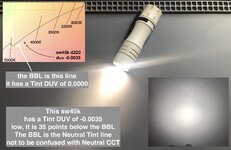This might have been discussed before,....but I was curious about something. Daylight has a Kelvin of 5000-6500. When I look outside, during the day,...it looks "warm" in color. But a flashlight with an LED that is 5000-6500 Kelvin looks more blue-ish and doesn't have that CRI color tone people like so much.
So.......you know...........what up with that?
So.......you know...........what up with that?



